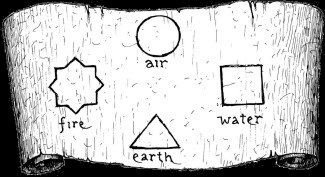Note: This information was taken from TSR's original AD&D adventure, the Temple of Elemental Evil.

Nodes of Elemental Evil |
Air Node
Within the Air Caverns, the atmosphere
is cool and windy. The relatively constant
60 degree temperature (F) is comfortable to
all herein, but the winds range from mild
gusts of 10-20 mph to full gales of 100 +
mph. The environmental damage is due to
dust, pebbles, and other debris blown by
the winds.
Those arriving in the air caverns appear on
a plateau atop a central spire, standing 200 feet
above the floor level and reaching to within 50
feet of the cavern's roof. A steep slope down
spirals widdershins from the peak.
Light seems to come from the ceiling of
the cavern, casting a soft twilight glow
throughout the area. The visibility from the
peak is fair; many cave entrances can be
dimly seen in the distance. Dense clouds of
random shapes and sizes drift in the great
cavern. Though they are constantly pushed
and torn by the winds, they do not disperse
easily. At floor level, however, visibility
varies widely. When necessary, the DM may
roll 2d4 to find the number of map squares
(each 50' across) visible in any one direction,
but this could change in a short time,
possibly only a round or two.
The slopes, stairs, and caverns themselves
are hewn of solid rock, apparently by
very good craftsmen. All surfaces are
strewn with rubble, an occasional bone or
bit of lost, worn equipment, and an infrequent
shallow pit or landslide.
Though most of the Air Caverns are dry
and fairly mild, some are dotted with
pools of icy water, with frozen lumps on the
walls. These caves are even cooler towards
their northern ends, where part of a glacial
outcropping can be seen.
Earth Node
The Earth Burrows are dark and slightly
damp--a typical cave-dungeon setting. The
temperature is a constant 45 degrees, with
little or no air movement. The environmental
damage comes from the ever-present
heavy dust in the air, and from occasional
rockslides, minor cave-ins, and so forth.
Those arriving in the Burrows appear in
the center cave, a large broad area 50 feet
tall at its center tapering to only 10-20 feet at
the side corridors.
The corridors have no light, and the
dusty air permits only half normal range of
sight, whether normal or infravision. Slopes
are few, and the stone is dug out, rather
than worked.
Fire Node
The rooms and corridors of the dreaded Fire
Pits are humid and hot--so hot that the subsequent
environmental damage is inflicted over
periods of exposure. The areas are lit, either
dimly or brightly, by the occasional pits of
burning embers and leaping flames, as noted
on the map.
Those arriving here appear in the central
room, faced with a choice of eight doors.
They, and all other portals in the Node, are
large stone constructions with brass fittings.
They stick frequently (-1 penalty to all 'open
doors' rolls), but are edged by ample cracks
which allow fire creatures and others of
mutable form to seep through them even
when closed.
The rooms and corridors, hewn from the
surrounding rock, are well-made, perhaps by
earth elementals or magic. Many surfaces are
scorched and scratched, but few are chipped.
Bits and scraps are rare, only found in small
piles and singed on the upper side.
Water Node
The Water Maze is a great indoor ocean, a
magical place suitable to both salt and freshwater
beings. The ceiling of the great cavern
casts a soft moonlight-bright glow. From
the central pool, one might imagine the
place to be a tropical atoll; but danger lurks
throughout.
The air is changeable, once a lilting warm
breeze and then suddenly a chilling draft.
Swirling eddies in both the water and the air
produce sudden changes in waves at any
time. Mists rise from the water, adding an
air of mystery and suspense to the visually
peaceful setting. But it is these oddly tinted
mists that poison the very air, causing the
given environmental damage to the unprotected.
The depth of the water varies widely but
averages about 50 feet. The dozens of
craggy islets reach 10 to 80 feet from the surface,
stretching towards the cavern roof far
overhead (100-150 feet up) like pointing
skeletal fingers. Icebergs dot the coldest part
of the water, mostly to the northeast corner
of the map.
Newcomers to the Node land asplash in
the central pool area, which is only 10 feet
deep and protected from most of the sea
dwellers by a coral reef. Some few small
scavengers might be lurking therein, but
they will probably avoid a group of nervous
humans.